Description
Rohde and Schwarz SMB100B – RF Signal Generator (8 kHz to 1, 3 or 6 GHz)
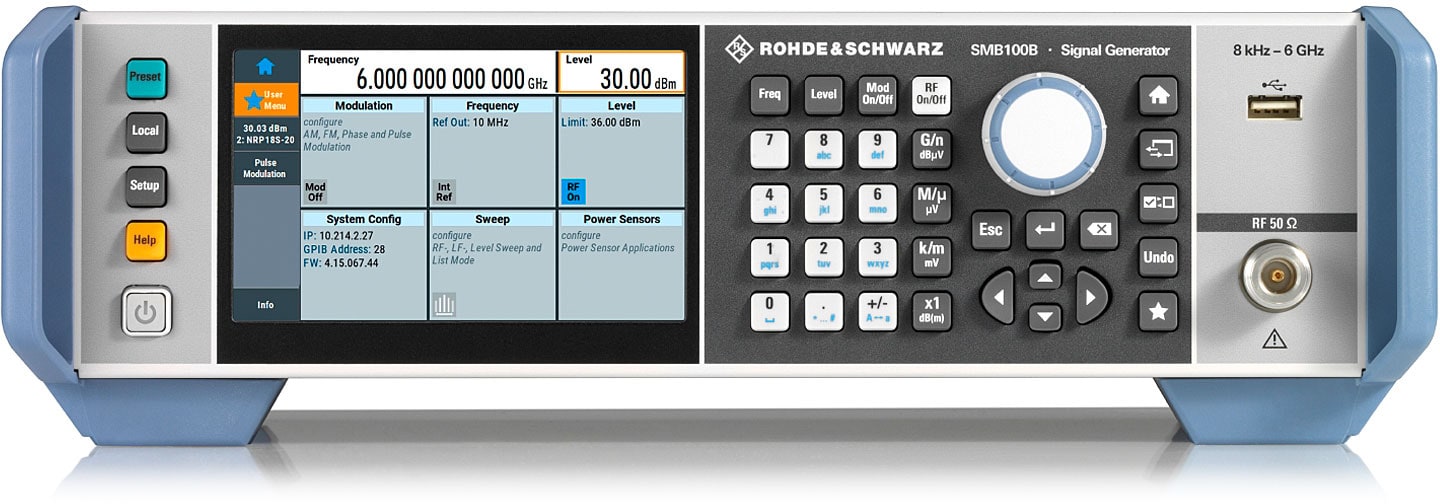
A frequency option must also be ordered with this device:
- SMBB-B101 (8 kHz to 1 GHz)
- SMBB-B103 (8 kHz to 3 GHz)
- SMBB-B106 (8 kHz to 6 GHz)
The new R&S SMB100B RF signal generator is all about performance and versatility in a small footprint. Outstanding spectral purity and very high output power combined with comprehensive functionality and very simple operation are some of the impressive features of the R&S SMB100B.
Front and Rear Panel Overview

- High-resolution touchscreen with easy-to-use graphical user interface
- Context-sensitive help system and comprehensive user manual
- The main screen clearly displays modulation, frequency and level settings as well as the system configuration,
the sweep mode and power sensor related parameters - Remote control via LAN (GPIB and USB with R&S®SMBB-B86 option)
- Input for external pulse modulation signal (R&S®SMBB-K22 option)
- Variable LF output (R&S®SMBB-K24 option)
- Standard USB connector for the R&S®NRP power sensors
- RF output connector (N female)
- Favorite key for simplified and fast operation via customizable user menu
- FM stereo connectors (R&S®SMBB-B5 option)
- 1 GHz reference input/output (R&S®SMBB-B3 option)
- Variable reference input/output from 1 MHz to 100 MHz (R&S®SMBB-K704 option)
Perfect for Signal Quality
In order to improve a DUT, the signal quality of the signal source has to be significantly better than the DUT’s performance. Thanks to its innovative synthesizer design, the R&S®SMB100B has very low SSB phase and wideband noise and excellent suppression of nonharmonic signal components.
Very Low SSB Phase Noise
The optional battery pack provides three hours of operation. With additional batteries and an additional charger, the operating time can be extended without interruption.
The R&S SMB100B has a very low SSB phase noise of -134 dBc at 1 GHz and an offset of 20 kHz (measured; 1 Hz bandwidth). The R&S SMBB-B1 option (OCXO) and the R&S SMBB-B1H option reduce the close-in phase noise.
Also wideband noise is very low. The R&S SMB100B achieves -153 dB/Hz (typ.) for a 1 GHz carrier at a frequency offset of 30 MHz. Other benefits of these options include significantly improved long-term stability of the reference frequency and much less temperature dependency.
Purest 1 GHz Reference Output
In addition to its RF output, the R&S SMB100B has a separate 1 GHz reference input and output. A 1 GHz reference signal provides better phase stability between the output signals of multiple coupled instruments than a 10 MHz reference signal. The SSB phase noise of this 1 GHz reference signal is shown in the diagram.
Single-sideband Phase Noise (1 GHz, 1 Hz Bandwidth, measured)

SSB phase noise of the R&S®SMB100B base unit, with the R&S®SMBB-B1 option (OCXO) and with the R&S®SMBB-B1H option (high performance OCXO)
Perfect for Output Power
The need for very high output power often means that a signal generator must be combined with an amplifier connected to its output. The R&S SMB100B offers a better alternative. With the R&S SMBB-B32 ultra high output power option, it is a calibrated one-box solution that saves space and money.
Ultra High Output Power
Since the R&S SMB100B provides very high output power, no external amplifier is required downstream. This simplifies the test setup and results in high absolute level accuracy. When equipped with the appropriate options, the R&S SMB100B delivers +34 dBm at 1 GHz and +31 dBm at 6 GHz (measured values).
Very High Dynamic Range
The usable dynamic range is defined by the difference between the maximum and minimum adjustable power. As soon as the lower end of the electronic setting range is reached, a switchable attenuator is activated to provide further attenuation. The R&S SMB100B has a minimum specified power of -127 dBm as standard (for f > 10 MHz). With its specified maximum adjustable power of +26 dBm (1 MHz < f ≤ 6 GHz), it has a very wide dynamic range of 153 dB.
The user always has the desired output power, regardless of whether the user is e.g. testing receiver sensitivity or needs high power levels for amplifier tests. The attenuator used in the R&S SMB100B is fully electronic. Compared to a mechanical attenuator, it is wear-free, noiseless and changes the power level significantly faster.
Unmatched Level Repeatability
Not only absolute level accuracy, but also level repeatability plays an important role. Especially for frequently repeated test sequences where the level is often changed, it is essential to be able to reproduce each individual level value during every repeated sequence. Here again the R&S SMB100B is best in class with a level repeatability of ±0.02 dB (1 GHz, 0 dBm, meas.).
Maximum Output Power (measured)

Measured output power for the base unit, with the high power option (R&S®SMBB-K31) and with the additional ultra high power option (R&S®SMBB-B32)
Perfect for Use
The user friendliness of the R&S SMB100B is evident in many ways. The RF signal generator is simple to operate, supports working with a connected R&S NRP power sensor and can emulate legacy instruments.
Ergonomic Operation Thanks to State-of-the-Art GUI with Touchscreen
The graphical user interface with high-resolution touchscreen makes the R&S SMB100B very easy to use. The main screen clearly displays all important parameters and information to save the user time when looking for functions.
The ability to save a user menu on the R&S SMB100B simplifies working with the instrument. Frequently used menu items can be added to the user menu so that the user can quickly and directly access all needed settings from a single menu.
Context-sensitive online help provides comprehensive information. It describes each parameter and setup menu in detail, states the setting range, and shows the associated remote control command. Users can also search for specific parameters in the user manual installed on the instrument.
The R&S SMB100B helps users quickly and correctly create remote control programs. The instrument’s built-in SCPI macro recorder with code generator can automatically record all manual settings and create an executable MATLAB script.

The main screen with all important parameters and information

Individual menu items can be added to the user menu. Added items are marked with a blue star
Support of R&S NRP Power Sensors
DUTs are often connected to the signal generator via long cables or other frequency-dependent components. It is therefore very important to compensate the frequency response. The R&S SMB100B provides a user correction (UCOR) function for this purpose. If the frequency response of external components is known, level correction values for different frequencies can be entered in the R&S SMB100B. The correction values between these frequency points are automatically interpolated.
The R&S NRP power sensor offers a much more user-friendly solution than manual entry. The power sensor is connected as shown in the figure. At the push of a button, the level correction values are automatically determined and saved in the UCOR table. When UCOR is activated, a frequency response compensated RF signal is available at the new reference plane for the DUT.
Setup and UCOR Function

Relative output power display when using cables and other components (with their own frequency responses) between the R&S®SMB100B and a DUT. Top: without UCOR. Bottom: with UCOR activated
Generators / Counters/RF Signal Generator Template | |
|---|---|
| Type(Generator) | Bench |
| Minimum Frequency Range (kHz) | 8 kHz (0.008 MHz) |
| Maximum Frequency Range | 6 GHz (6000 MHz) |
| Modulation Types (generator) | AM, CW, FM, Other, PM |
| Output dB Range Min | -110 dBm (-110 dB) |
| Output dB Range Max | 18 dBm (18 dB) |
| Memory for Presets | Yes |
| Stereo | Yes |
| Variable/Step Attenuator | Yes |
| Made for catv/TV market | No |
Product General Attributes | |
| Product Weight | 15 LBS |
| Product Height | 4.3 IN |
| Product Length | 14.7 IN |
| Product Width | 13.6 IN |
| Shipping Weight | 17.25 LBS |
| HTS/Schedule B Number | 9030400000 |
| ECCN Number | 3A992 |
| Country of Origin | Germany |


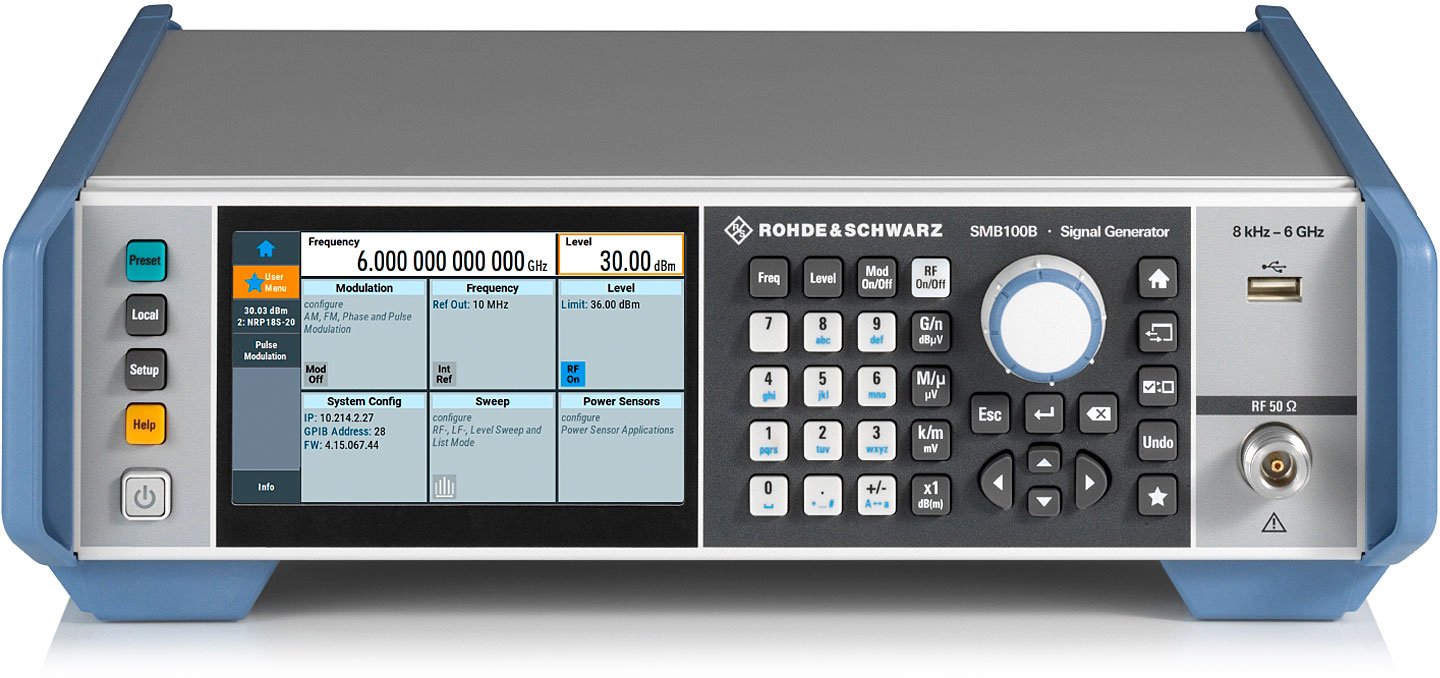
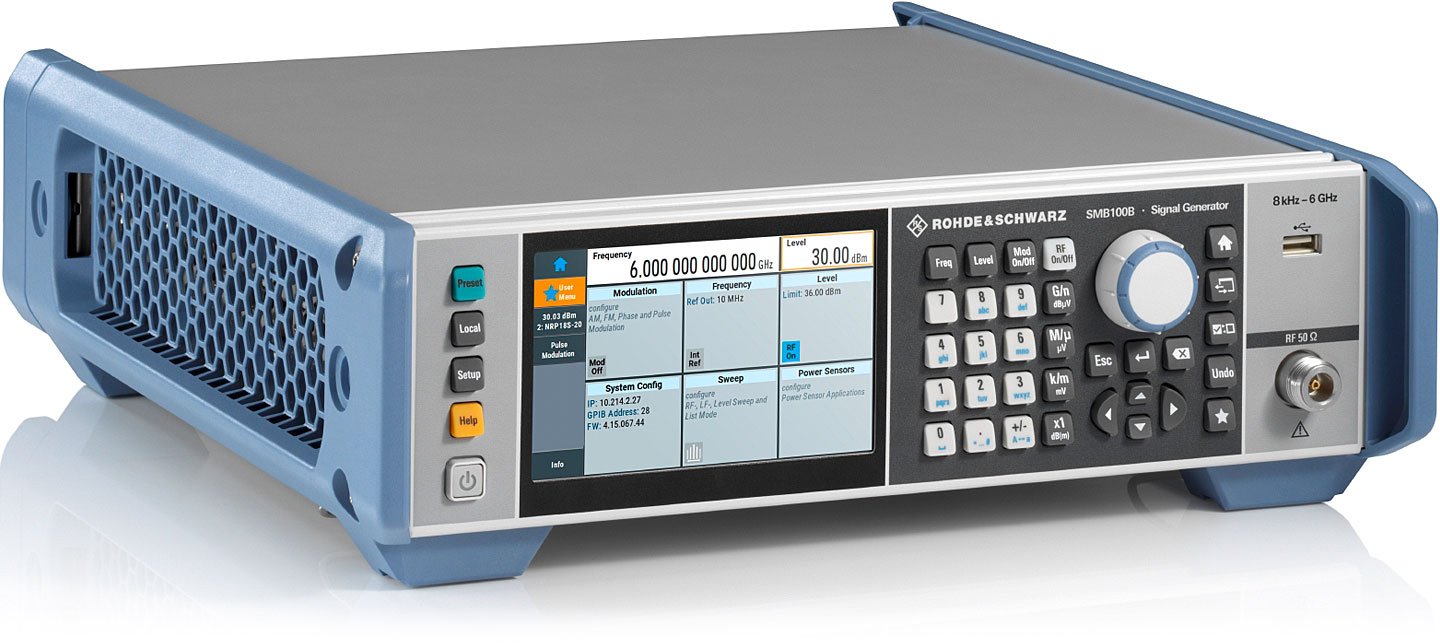
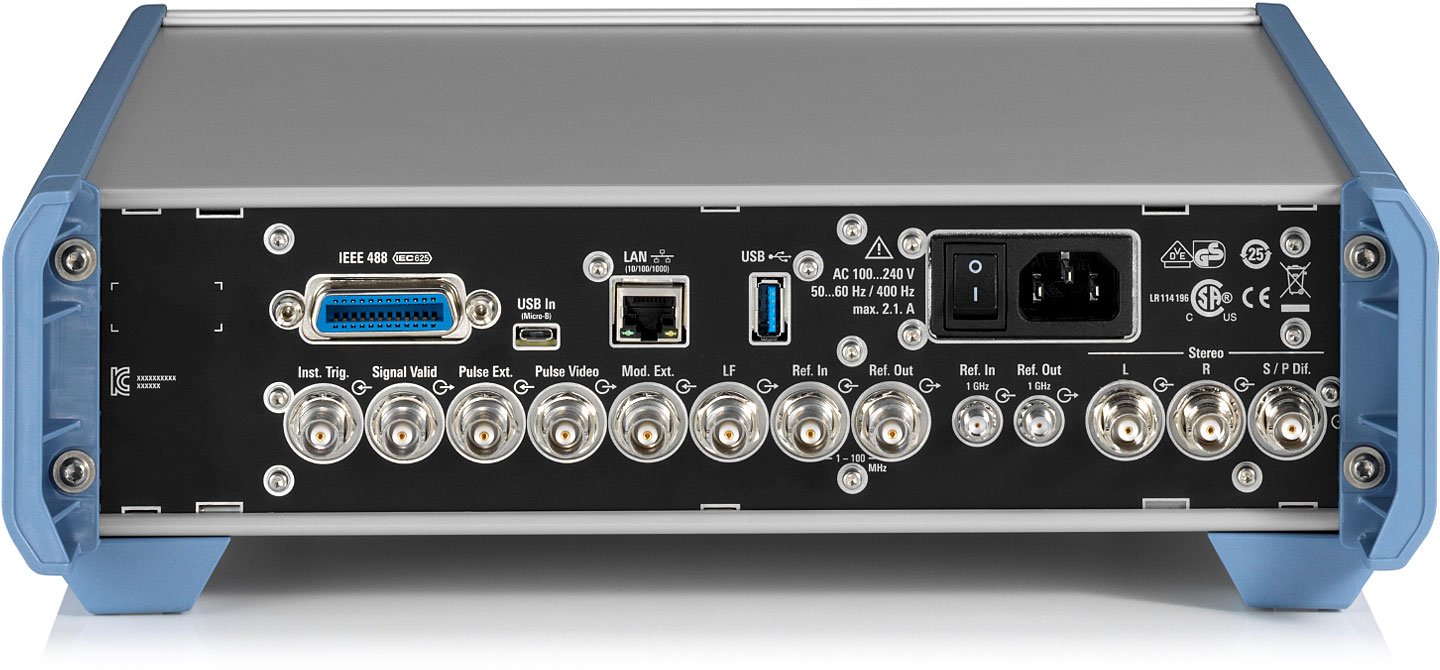
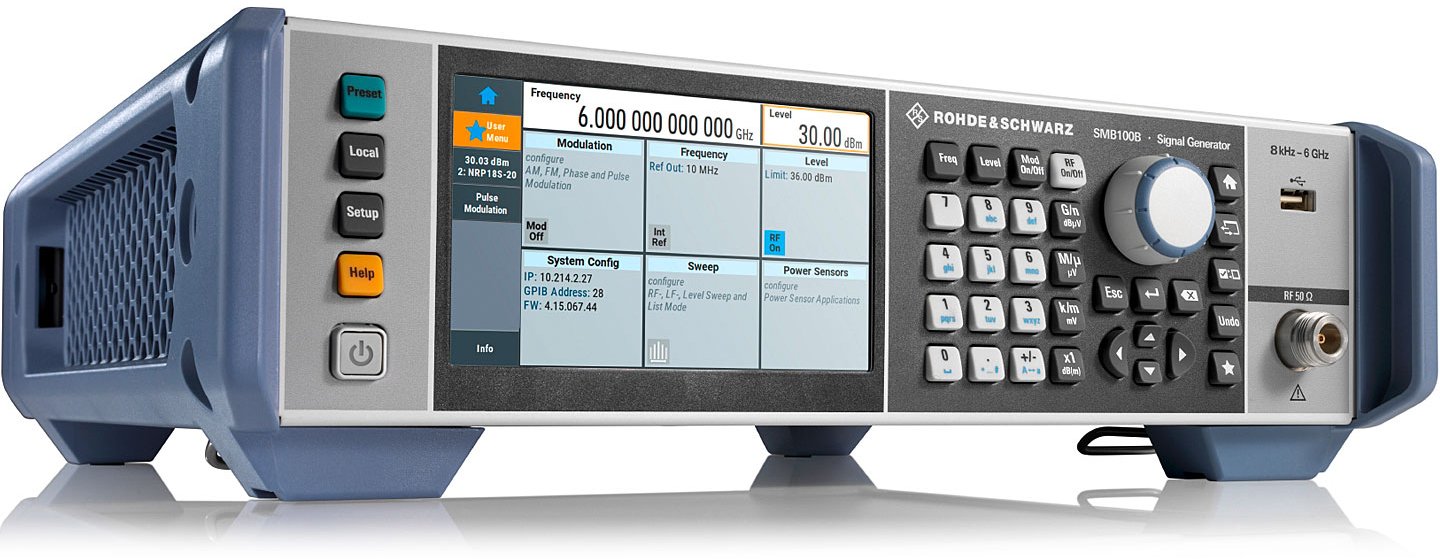












Reviews
There are no reviews yet.